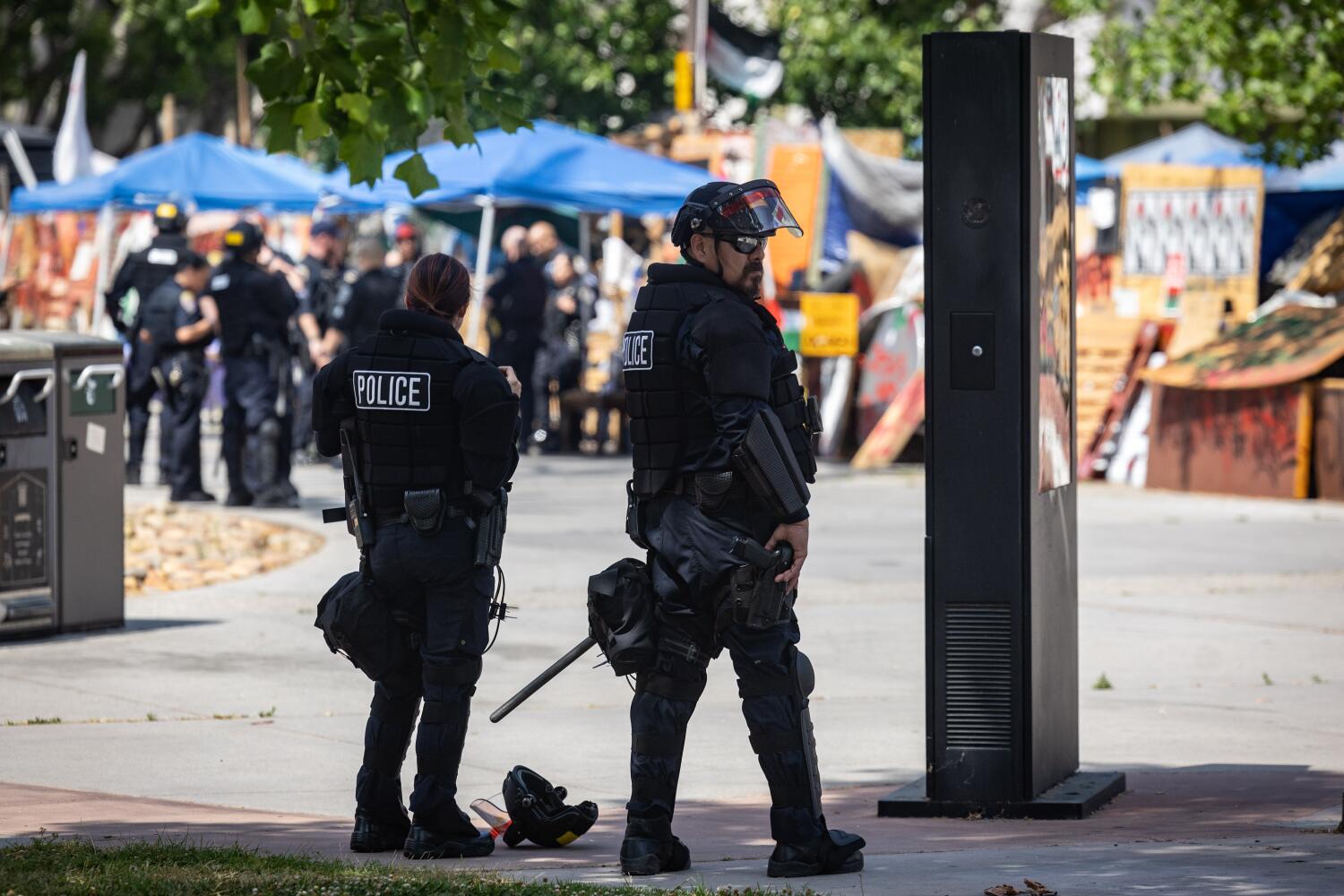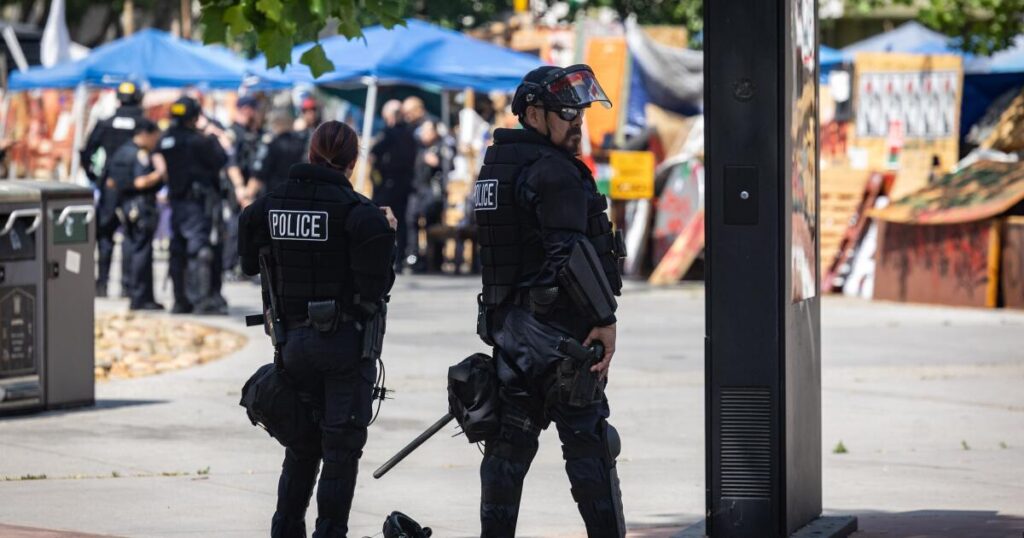
Dozens of police in riot gear from multiple agencies raided a pro-Palestinian encampment at Cal State Los Angeles on Monday afternoon, dismantling the compound and forcing protesters to leave after tensions escalated last week.
University spokesman Erik Frost Hollins said police issued dispersal orders in English and Spanish around 1:20 p.m. for the remaining protesters in the camp, about 10 people. Leave voluntarily.
It was the last major pro-Palestinian protest camp at a Los Angeles university.
Hollins said officers from multiple campus police departments, including the Los Angeles Police Department, California Highway Patrol and California State University, did not use any weapons to disperse the protesters and made no arrests. Campus security and police have blocked all road entrances to the campus, but exits are open and the campus can be accessed on foot.
Using forklifts and large dumpsters, crews removed and hauled away painted and graffiti-covered boards around the encampment. Many were painted in the red, green, white and black colors of the Palestinian flag, with the words “Gaza Solidarity Camp” and “Google LASD Gang” emblazoned on them.
Students launched the camp on May 1 to demand that Cal State Los Angeles and the California State University system disclose their investments, “divest from companies that financially and materially support the genocide, and defend the Palestinian people’s right to resistance and return,” and declares genocide that Gaza and the occupation of Palestine are illegal under international law,” a statement from Cal State Students for Justice in Palestine said
Hollins said Cal State Los Angeles Chancellor Berenicia Johnson-Ines has visited the camp twice since its inception and had numerous conversations with protesters.
While other universities, including USC and UCLA, moved relatively quickly to close pro-Palestinian camps in the spring, the camp at Cal State Los Angeles was tolerated for several weeks. For the most part, there have been no violent controversies or conflicts involving students, campus officials, or police.
But the nature of the relationship between the university and the protesters changed on Wednesday, when dozens of protesters barricaded themselves inside the Student Services Building, with some administrators inside, for more than nine hours, Hollins said. Students for Justice in Palestine said management was free to leave at any time, if escorted. The organization said it conveyed the message directly and through Instagram. About 60 employees were in the building for about two hours before leaving. About a dozen people, including Ines and Hollins, volunteered to stay.
Hollins said there was no specific incident that prompted the school to call police on Monday, but he said officials have been discussing dismantling the encampment since the building was occupied.
In a campus-wide email Monday afternoon, Ians said that “those associated with the encampment engaged in illegal conduct during the occupation of the building that put faculty, staff and students” at risk, “including assault, vandalism, Destruction of property and robbery.
“For the safety of the entire campus community, the only acceptable option is to disband and disperse the encampment. We will not negotiate with those who use disruption and intimidation to achieve their goals,” she wrote. “It became clear to me that public officials carrying out their public mission at a public university in one of the most under-resourced communities in the region were victimized by those who claimed to be protesting injustice.”
Enes said the campus has been holding classes virtually since the middle of last week and will continue to do so on Tuesday. The university is conducting summer sessions, which will end on August 10.
On Monday, the Los Angeles chapter of the California State University-Palestine Justice Institute said it had worried for weeks that the peace camp could be compromised as negotiations stalled and frustration grew.
“While the June 12 protests brought a turning point for the camp, we suggest that prompt, good-faith negotiations with students over divestment demands are the best way to resolve the issue,” the group said in a letter posted on Instagram. pathway. “We also recommend that you more clearly communicate the timeline and process for evacuation with camp students, rather than engaging in unannounced possible cleanup actions as other universities have done, which can cause trauma, harm and violence. “
Cal State Los Angeles Students for Justice in Palestine posted a video on Instagram that appeared to show activists talking to police in riot gear who had gathered outside a barricade at the camp. “We have to do what they say,” a voice from the camp said in the background. “Can we go?” one activist said to police as the activist stared at law enforcement. “Yes!” Several officers said in unison. “I want you to leave,” one officer said. “I wish you’d spent less time in there.”
By 5:30 p.m., the camp was nearly dismantled. Waiting for slogans.
The student services building, which was occupied last week, remains cordoned off by police. Tables and chairs on the terrace had been overturned, and graffiti remained on the ground-level windows.
A campus security officer who was not authorized to speak to the media said officials will clear the construction area after the camp materials are completely removed. They said they were unsure whether that would happen Monday.
Onlookers, including students and nearby residents, expressed surprise on Monday at the dismantling of the camp and the presence of police.
“I don’t agree with what this camp represents, but I’ve walked by it many times,” said James Wheeler.
“These were mostly peaceful students,” Wheeler said. “Other than the fact that they occupied the building once, their protests were nothing like the conflicts or controversies you see at other universities.”
A student who said he knew members of the camp said the police response was “exaggerated” considering that about 10 activists left the scene voluntarily. “They sent out all these police cars, these riot police, blocking the streets, but it was all in vain. Things were getting out of hand,” said the student, who declined to give his name.
Ines said in Monday’s letter that the university “needs to face the consequences of internal sheltering.” [the student services building]anger at the destruction of the student spaces they worked so hard to create, and sadness at not feeling safe on the campus we all cherish.
Hollins said that during the sit-in, one employee “had something thrown at his head,” while another was pushed to the door and then moved out of the way as protesters forced their way into the building.
Hollins said protesters severely damaged the building and the university is still investigating to determine whether an arrest should be made. Protesters covered their faces and took other steps to hide their identities, complicating the investigation, they said.
Activists defended their actions.
“Despite intense police pressure from the University Police Department, the Los Angeles Police Department, and the Los Angeles Sheriff’s Department, the defense of sit-ins and solidarity camps will continue until CSULA ends its financial and material support for the genocide,” the group said last week in a press release. said in a statement.
Times staff writer Angie Orellana Hernandez contributed to this report.

